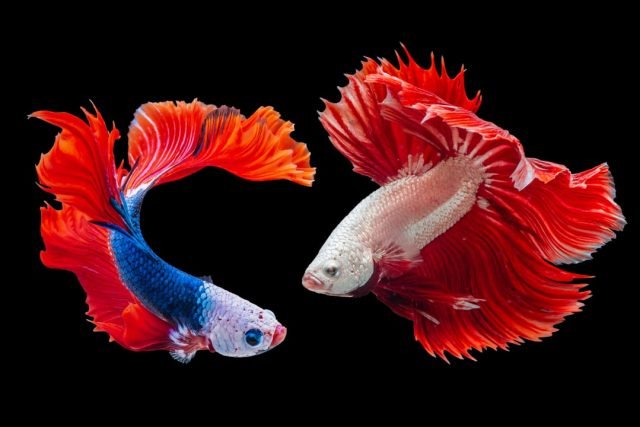Ultimate Guide to Aquarium Fish Care, covering topics from setting up the aquarium to feeding, maintenance, water quality management, and common fish diseases and treatments.
Table of Contents
Introduction: Understanding the Importance of Proper Aquarium Fish Care
Proper care and maintenance of aquarium fish are crucial for ensuring the health and well-being of these aquatic creatures, as it helps replicate their natural habitat within the confined space of an aquarium. By following essential guidelines and practices, aquarium owners can create a thriving environment that supports the longevity and happiness of their fish companions.
Maintaining a healthy aquarium not only benefits the fish but also provides a visually appealing and calming space for enthusiasts to enjoy. For instance, incorporating live aquatic plants not only enhances the aesthetics of the tank but also serves functional purposes like oxygenation and nitrate absorption. These plants create a more natural ecosystem within the aquarium, contributing to the overall well-being of the fish by closely resembling their native habitats.
Furthermore, understanding the nitrogen cycle is fundamental in establishing a balanced aquarium environment. This process involves the conversion of toxic ammonia excreted by fish into less harmful nitrates through beneficial bacteria. By comprehending and managing this cycle effectively, aquarium owners can maintain water quality, reduce stress on the fish, and promote a healthy biological filtration system in the tank.
Setting up an Aquarium
When preparing an aquarium for fish, it is important to consider the beneficial aspects of incorporating live plants into the tank. Live plants serve a dual purpose by not only enhancing the aesthetic appeal of the aquarium but also contributing to the overall health of the aquatic ecosystem. For instance, plants play a significant role in absorbing nitrates, a byproduct that can be harmful to fish if present in high concentrations. By utilizing live plants, aquarium owners can create a more balanced and stable environment for their fish.
Moreover, understanding the nitrogen cycle is fundamental in establishing a sustainable and thriving aquarium. This biological process involves the conversion of toxic ammonia, primarily excreted by fish waste and decaying organic matter, into nitrites and eventually into nitrates through the activity of beneficial bacteria. By fostering a healthy nitrogen cycle, aquarium enthusiasts can maintain optimal water quality, ensuring a safe and habitable space for their aquatic pets to thrive.
Lastly, acclimating fish to their new aquatic home is a critical step in the setup process. Fish are sensitive to sudden changes in water parameters, and a gradual introduction helps minimize stress and potential health issues. By acclimating fish slowly to the aquarium water, hobbyists can safeguard the well-being of their aquatic companions and facilitate a successful transition into their new habitat.
 Choosing the Right Fish
Choosing the Right Fish
When choosing fish for your aquarium, it’s crucial to take into account not only the size of the fish when fully grown but also their behavior and compatibility with other species in the tank. For example, Betta fish, also known as Siamese fighting fish, are known to be aggressive towards other males of the same species, making it necessary to house them alone or with peaceful tank mates like certain species of catfish or tetras. Understanding the social dynamics and individual requirements of each species can help prevent conflicts and ensure a harmonious community.
Furthermore, researching the specific water parameters needed by different fish species is essential to create an environment where all inhabitants can thrive. For instance, African cichlids are known to prefer hard water with a higher pH level, while neon tetras thrive in slightly acidic water. By tailoring the aquarium conditions to suit the specific needs of the fish species present, you can promote their overall health and well-being. Additionally, considering the tank size requirements of each species is vital to prevent overcrowding, which can lead to stress, aggression, and potential health issues among the fish. By carefully selecting fish based on their size, behavior, and environmental needs, you can create a diverse and sustainable aquatic ecosystem in your aquarium.
Feeding and Nutrition
Proper feeding and nutrition play a vital role in maintaining the health and well-being of aquarium fish. It is essential to consider the specific dietary requirements of each fish species when planning their meals. For instance, herbivorous fish like plecos require a diet rich in algae wafers and fresh vegetables, while carnivorous species such as Bettas thrive on protein-rich foods like bloodworms or brine shrimp. By researching and understanding the dietary preferences of different fish species, aquarists can ensure that their fish receive the necessary nutrients for optimal health.
Moreover, feeding practices should also take into account the feeding behaviors of fish. For example, bottom-dwelling fish like Corydoras catfish may require sinking pellets or tablets to ensure they receive their share of food, as they tend to feed closer to the substrate. On the other hand, surface-dwelling fish like guppies may prefer floating flakes or pellets that remain at the water’s surface. By observing the behavior of fish during feeding times, aquarists can tailor their feeding strategies to accommodate the various preferences and behaviors of the fish in their aquarium. This personalized approach not only promotes proper nutrition but also encourages natural feeding behaviors among the fish, contributing to their overall well-being.
Tank Maintenance
Regular maintenance tasks play a crucial role in the overall health and well-being of the aquarium inhabitants. In addition to cleaning the aquarium glass for improved visibility and aesthetics, it is essential to pay attention to other maintenance aspects. For instance, vacuuming the gravel during water changes helps remove debris and waste that can accumulate over time, contributing to elevated toxin levels in the water. By incorporating this practice into the regular maintenance routine, aquarists can ensure a cleaner and healthier environment for their fish.
Moreover, monitoring water parameters such as pH, ammonia, nitrites, and nitrates is vital for detecting any deviations from the ideal levels promptly. For instance, high levels of ammonia or nitrites can be harmful to fish, causing stress and potentially leading to health issues. By conducting regular water tests and addressing any imbalances promptly, aquarists can prevent water quality issues and create a more stable and habitable aquatic environment for their fish. Additionally, maintaining proper filtration systems by replacing filter media as recommended by the manufacturer is essential for effective removal of impurities and waste, contributing to cleaner and clearer water.
 Water Quality Management
Water Quality Management
Water quality management in an aquarium is a fundamental aspect of fish care that directly impacts the well-being of aquatic inhabitants. In addition to stable water temperature maintenance and beneficial bacteria establishment, it is crucial to regularly monitor water parameters such as pH, ammonia, nitrites, and nitrates to ensure a healthy aquatic environment. For instance, sudden spikes in ammonia or nitrite levels can be toxic to fish, leading to stress and potential health issues. By conducting routine water tests and promptly addressing any fluctuations, aquarists can prevent water quality-related problems and provide a safe habitat for their fish.
Furthermore, beyond the initial setup phase, maintaining water quality involves performing regular partial water changes. These water changes help remove accumulated waste, excess nutrients, and chemicals, ensuring a clean and balanced ecosystem for the fish. For example, replacing approximately 10-20% of the aquarium water every 1-2 weeks can prevent the buildup of harmful substances and provide a fresh environment for the fish to thrive. Additionally, proper filtration, adequate oxygenation, and the use of quality water conditioners play vital roles in sustaining optimal water quality. By adhering to these practices, aquarists can establish a stable and healthy aquatic environment that promotes the longevity and well-being of their beloved fish.
Common Fish Diseases and Treatments
Aquarium owners should be vigilant about common fish diseases and their treatments to protect the well-being of their aquatic companions. One prevalent ailment is ich, caused by external parasites that manifest as white spots on the fish’s body. To address this issue, using medication and slightly elevating water temperatures can effectively eliminate these parasites. For instance, increasing the temperature to around 82-85°F for a few days can accelerate the lifecycle of the parasite, making them more susceptible to treatment.
Another health concern for fish is internal infections, which can be challenging to detect early. Symptoms may include loss of appetite, abnormal swimming behavior, or color changes. In such cases, administering antibiotics through medicated food or directly into the water can target the infection and aid in the fish’s recovery. By promptly identifying these issues and providing suitable treatment, aquarium enthusiasts can enhance the chances of a full recovery for their fish, maintaining a vibrant and thriving aquatic environment.
Furthermore, implementing preventive strategies like setting up a quarantine tank for new fish arrivals and conducting regular health assessments through observation can significantly reduce the risk of disease transmission among aquatic species. By isolating new additions before introducing them to the main aquarium and keeping a close eye on fish behavior and appearance, owners can promptly address any potential health concerns and uphold the overall well-being of their aquatic community.
 Conclusion: Ensuring Long-Term Health and Happiness for Your Aquarium Fish
Conclusion: Ensuring Long-Term Health and Happiness for Your Aquarium Fish
In addition to the essential aspects of fish care discussed in this comprehensive guide, it is crucial to understand the social dynamics among different fish species within an aquarium to ensure their well-being and compatibility. Some fish species exhibit aggressive behaviors, while others are more peaceful, requiring careful consideration when selecting tankmates to prevent conflicts and stress. For example, Betta fish, also known as Siamese fighting fish, are territorial and should typically be kept alone or with non-aggressive tankmates to avoid potential aggression issues.
Furthermore, creating a stimulating environment with appropriate hiding spots, plants, and decorations is essential for the mental stimulation and overall happiness of aquarium fish. For instance, adding driftwood or caves in the tank provides shelter for fish to retreat to when feeling stressed or threatened, mimicking their natural habitat and reducing anxiety levels. By enriching the aquarium environment, owners can observe natural behaviors in their fish, leading to a more fulfilling and engaging experience for both the fish and the hobbyist.
You May Lik The 7 Ultimate Guide for Pets Lover for Flexibility


 Choosing the Right Fish
Choosing the Right Fish Water Quality Management
Water Quality Management Conclusion: Ensuring Long-Term Health and Happiness for Your Aquarium Fish
Conclusion: Ensuring Long-Term Health and Happiness for Your Aquarium Fish








